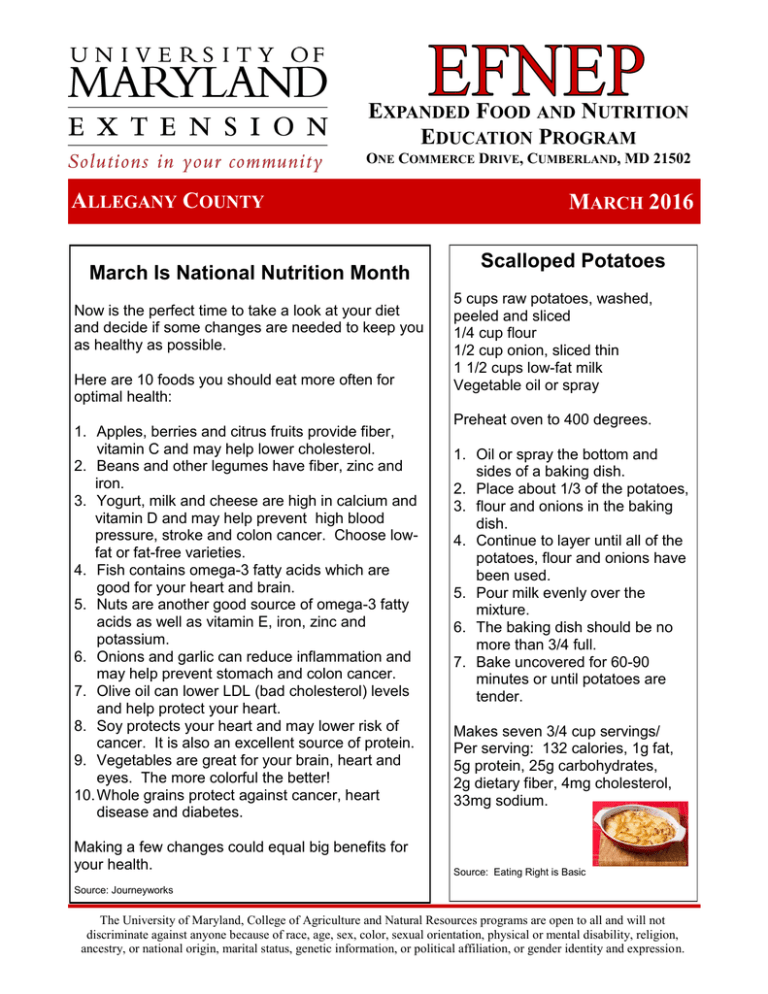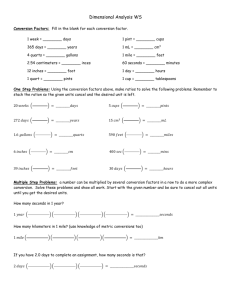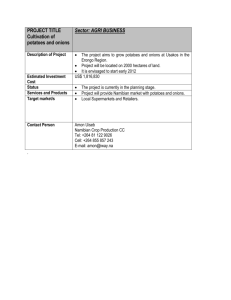E F N
advertisement

EXPANDED FOOD AND NUTRITION EDUCATION PROGRAM ONE COMMERCE DRIVE, CUMBERLAND, MD 21502 ALLEGANY COUNTY March Is National Nutrition Month Now is the perfect time to take a look at your diet and decide if some changes are needed to keep you as healthy as possible. Here are 10 foods you should eat more often for optimal health: 1. Apples, berries and citrus fruits provide fiber, vitamin C and may help lower cholesterol. 2. Beans and other legumes have fiber, zinc and iron. 3. Yogurt, milk and cheese are high in calcium and vitamin D and may help prevent high blood pressure, stroke and colon cancer. Choose lowfat or fat-free varieties. 4. Fish contains omega-3 fatty acids which are good for your heart and brain. 5. Nuts are another good source of omega-3 fatty acids as well as vitamin E, iron, zinc and potassium. 6. Onions and garlic can reduce inflammation and may help prevent stomach and colon cancer. 7. Olive oil can lower LDL (bad cholesterol) levels and help protect your heart. 8. Soy protects your heart and may lower risk of cancer. It is also an excellent source of protein. 9. Vegetables are great for your brain, heart and eyes. The more colorful the better! 10. Whole grains protect against cancer, heart disease and diabetes. Making a few changes could equal big benefits for your health. MARCH 2016 Scalloped Potatoes 5 cups raw potatoes, washed, peeled and sliced 1/4 cup flour 1/2 cup onion, sliced thin 1 1/2 cups low-fat milk Vegetable oil or spray Preheat oven to 400 degrees. 1. Oil or spray the bottom and sides of a baking dish. 2. Place about 1/3 of the potatoes, 3. flour and onions in the baking dish. 4. Continue to layer until all of the potatoes, flour and onions have been used. 5. Pour milk evenly over the mixture. 6. The baking dish should be no more than 3/4 full. 7. Bake uncovered for 60-90 minutes or until potatoes are tender. Makes seven 3/4 cup servings/ Per serving: 132 calories, 1g fat, 5g protein, 25g carbohydrates, 2g dietary fiber, 4mg cholesterol, 33mg sodium. Source: Eating Right is Basic Source: Journeyworks The University of Maryland, College of Agriculture and Natural Resources programs are open to all and will not discriminate against anyone because of race, age, sex, color, sexual orientation, physical or mental disability, religion, ancestry, or national origin, marital status, genetic information, or political affiliation, or gender identity and expression. How much added sugar? 5 Foods to Avoid The government released the latest edition of Dietary Guidelines for Americans in January. They encourage Americans to focus on eating a healthful diet to achieve and maintain weight, promote health and prevent disease. One of the newest additions to the guidelines is a limit on added sugars in the diet. The recommendation is to eat less than 10% of calories per day from added sugars. This translates to 40- 50 grams (10-12 teaspoons) for 1600-2000 calorie diets. Most of the added sugar in our diets come from processed foods, not from the sugar bowl. The table below lists some of the sources of added sugars in our diets. Food item Teaspoons of sugar 1. Saturated fats and trans fats are “bad” fats which are not heart-healthy. 2. Added sugars like corn syrup, sucrose and others add calories but no nutrition. 3. Salt and sodium raise your risk for high blood pressure. 4. Refined grains such as white flour and white rice are low in fiber and nutrients. 16 oz. regular soda 12 teaspoons 1 pouch Capri-Sun™ fruit drink 3 teaspoons 1 brownie 5 teaspoons 1 cup chocolate low fat milk 3 teaspoons 1 frosted pop tart 4 teaspoons 5. Alcohol is bad for your weight and your mood. 1 pouch of fruit snacks 3 teaspoons Source: Journeyworks Lisa McCoy, MS, RDN, Extension Educator , FCS-Healthy Living Create your Nutrition Rainbow! In celebration of National Nutrition Month, see if you can eat the rainbow this month! Materials: Piece of paper Crayons/markers Used grocery circulars or magazines with food pictures Glue stick 1. Draw one rainbow line with each color (red, orange, yellow, green, blue, purple) - leave 1-2 inches between the lines. 2. Each time you eat a nutritious food, find where it fits on the rainbow. Draw or glue a picture of the food on the correct rainbow line. 3. At the end of the month, see how much you filled up your rainbow! Source: https://www.pinterest.com/pin/ ASvGhPSm9I6IziYzYvcsZBb5X4vjJGmGBi7uC7QUcXB9i0pE3-_Vogs/ Newsletter prepared by: Eileen Morgan and Kathy Kinsman The Expanded Food and Nutrition Education Program (EFNEP) helps families, Eat better, Feel better, and Cut food costs. To find out more about EFNEP contact: University of Maryland 301-724-3320 Kathy Kinsman—kkinsman@umd.edu Sara Barnard—sbarnard@umd.edu Linda Ashburn—lashburn@umd.edu (Coordinator) http://www.extension.umd.edu/


